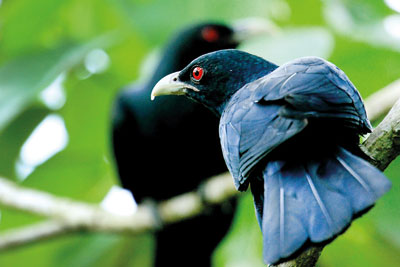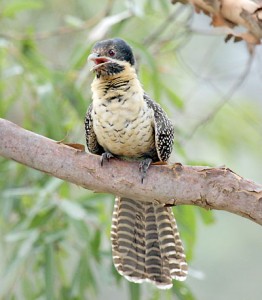News
Koha’s call overseas comes from another species

The Male Asian Koel Pic by Udara Samara Samaraweera
The Koha or Asian Koel (Eudynamys scolopaceus) is considered the harbinger of Sinhala and Tamil New Year for its beautiful song aimed at attracting a mate.
Its call can also be heard beyond Sri Lanka’s shores.
The Koha’s call is heard even in Australia, reminding Sri Lankans who live there of Avurudu.
One Sri Lankan who heard the bird sing, asked last year: “What on earth was a Koha doing in Sydney?”
A search on the video sharing social media platform YouTube suggests the Sydney Koha is different. It is not the same species found in our island, but the Eastern Koel or Pacific Koel scientifically classified as Eudynamys orientalis.
This bird is also called the Common Koel and its male is easily identified by its glossy black plumage, tinged with blue and green, and striking red eye – similar to the Koha found in Sri Lanka. The female has glossy brown upper parts, heavily spotted with white, and a black crown.
But unlike in this part of Asia, the Koels in Australia start to sing in September or October. According to BirdLife Australia, the Eastern Koel is a species that migrated to Australia from areas north – New Guinea, Indonesia and possibly the Philippines. It breeds in northern and eastern Australia, mostly in Queensland and NSW, southwards at least to Sydney, where they are common in the suburbs. A few venture into eastern Victoria, and vagrants have been seen as far afield as Melbourne, the Murray River and Adelaide. They remain until March or April, when they return to their non-breeding grounds.
This explains what Sri Lankans living in Australia have been hearing.
It is colloquially known as the rainbird or stormbird, as its call is usually more prevalent before or during stormy weather.

The Pacific Koel
According to the literature, the closely related Asian Koel, Black-billed Koel and Pacific Koel form a superspecies which are sometimes treated as subspecies. Superspecies is defined as “a group of largely allopatric species which are descended from a common evolutionary ancestor and are closely related but too distinct to be regarded as subspecies of one species”.
The Asian Koel is a brood parasite which lays it eggs in the nests of some other birds. In Sri Lanka, the Asian Koel particularly chooses a crow’s nest. But in the Australian conditions, the Eastern Koel lays its eggs in the nests of Red Wattlebird, friarbirds, the Magpie-lark and figbirds that are usually smaller than the Koel. The young Koel will grow to nearly twice the size of the parents, but the foster parents continue feeding it until they realize the mistake.
Eventually, the young birds migrate northwards, usually later than the adults, to return as a breeding bird the following spring, accordign to the BirdLife Australia.
The songs of the male Eastern Koel amazingly resemble those of the Koha in Sri Lanka. Visit www.youtube.com and search for “Eastern Koel Calling” to listen to their calls.

